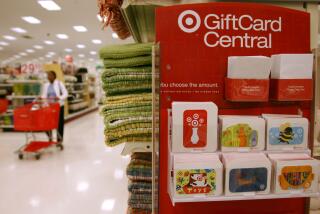Cards ‘Good Anywhere
- Share via
It’s hard enough to understand the billing and fees on a single charge card, and that’s only the top third of a financial iceberg. Beyond the consumer’s own card transaction is a system of contracts and interchanges that go some way toward explaining both the costs and the profitability of the whole card business. Such backstage operations rarely interest the consumer, who “just wants to have the convenience of a piece of plastic,” says Security Pacific Bankcard vice president Jack Levine, “and to know it’s going to be accepted.”
But sometimes a card that’s supposed to be Good Anywhere isn’t. And it has nothing to do with the consumer, who may be the ultimate customer but is probably not the most important.
Let’s start backstage with bank cards, such as MasterCard and Visa. Many banks that issue cards to consumers are also aggressively signing up merchants, who need someone to process and collect on the charge sales, and authorize the purchase. When someone charges something over the “floor limit” (often $50), the merchant checks it with his “merchant bank,” which either checks the account in its own computer (if it issued the card), or in a few seconds more, checks it through a MasterCard or Visa computer network of other “issuer” banks both across the street and around the world.
Electronic Activity
At day’s end, the merchant deposits all the sales drafts at his bank to be posted to his account that night, just like checks. The next day, the bank separates out all the “foreign drafts” (all but its own card holders’) and sends them to MasterCard or Visa, which sorts them and ships them to the issuing banks to be posted to consumer accounts. The issuing bank then sends back the money due by the same channel .
Most of this activity is electronic: There are no slips of paper flying through the air. It is also considerable--Bank of America alone may process a half-million items a day--but very fast, the whole process taking less than three days from the moment of charge.
Even electronically, however, nothing flies free. Visa and MasterCard charge the merchant bank for the use of their networks, and the issuer bank takes part of the “settlement” fee because it is, after all, doing the ultimate billing and financing. The merchant bank is thus sharing what it got from the merchant for all the processing--usually a few cents per every dollar of sales. (Since such “third-party” charge processors handle over half of the nation’s total annual charge volume of $293 billion, 3% or 4% is a fair chunk to share.)
The exact percentage is individually negotiated, dependent on the volume of sales handled and the sophistication of the handling (phone and feet versus electronics), and it is negotiated very closely. Banks regularly “woo the major accounts we don’t already have,” says B of A vice president Jack Shaffer, and merchants “shop for the best deal we can get in terms of transmission cost and systems technology, and we shop it every year,” says Joanna Logsdon, general credit manager for Bullock’s stores in California.
Other Cards
As for other cards, merchants handle their own “house” card charges, of course, but have in-house processing costs. And “travel and entertainment” (or “T&E;”) card companies such as American Express make their own contracts with merchants, provide their own authorizations, and take their own fee. Again, the percentage varies, depending on the merchant’s charge volume and chosen method of submission and payment--a simple mail exchange, or an “express deposit” at a local bank under contract to American Express-- but it’s generally higher than bank cards because American Express bills, payable in full each month, earn no finance charges.
Since all charge systems have a price, merchants weigh the benefits of each against its cost: The consumer’s particular card is therefore not sure to be “good anywhere,” as most companies imply, but only at certain merchants signed up for that system. Some stores and services skip American Express, for example, because they’re unwilling to wait for mailed payments or to pay extra for “express deposit.” Others particularly want American Express because it’s supposed to bring them high-income tourists or business travelers, but they may skip Diners Club or Carte Blanche, which have fewer members.
Some major stores don’t accept the mass-market bank cards, figuring that those are wielded by more local customers, and preferring that local people get store cards so they can be sent catalogues, sale notices and other promotional matter. If everyone used undifferentiated cards, “we’d lose control of our customers over time,” says Winston Bowman, Broadway stores vice president, “and the long-term effect would be an erosion of business.”
Given the extra cost of charge systems, many people think there should be two tiers of retail prices, so consumers who pay cash aren’t subsidizing those who charge. But that’s another question, and another column.
More to Read
Inside the business of entertainment
The Wide Shot brings you news, analysis and insights on everything from streaming wars to production — and what it all means for the future.
You may occasionally receive promotional content from the Los Angeles Times.










